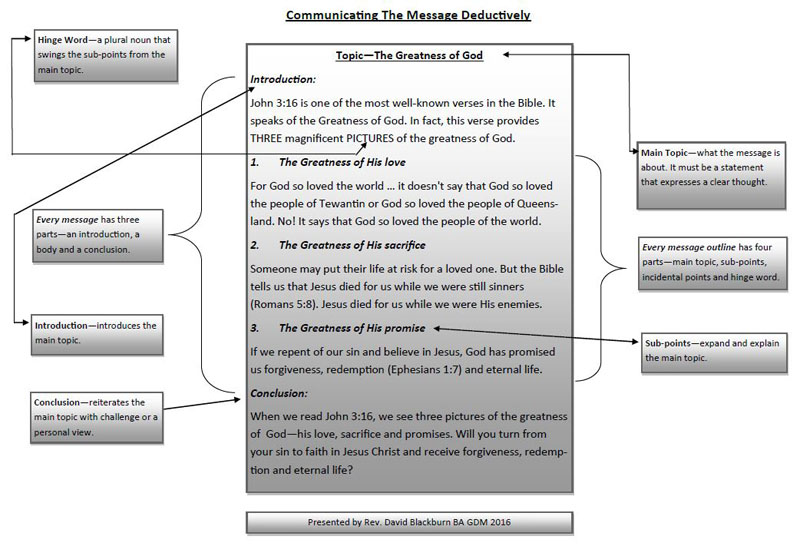How To Write a Sermon Introduction: Before we look at how to write a sermon introduction, we need to grasp the fact that there are several structural components to the sermon and the introduction is only one part of those structural components.
There are four types of sermon introductions. They are (1) introductions that command attention, (2) introductions that uncover needs, (3) introductions that introduce the body of the sermon and (4) introductions that have other characteristics.

As you can see in the image below, there are six structural components of the sermon – the title or topic, the introduction, the main points, the sub-points, the illustrations and the conclusion.
The introduction is written once you have finished writing your sermon outline which involves the topic, the main points, the sub-points and the illustrations. Therefore, your introduction should introduce to your audience the subject of your sermon outline, which of course is the body of your sermon.

As Haddon Robinson writes: “Not only does an introduction introduce you to the audience, but your introduction should introduce your audience to the subject of your sermon idea. The characteristics of effective introductions grow out of that purpose.”
In light of Robinson’s definition of an introduction, there are four features to an effective introduction.
1. An Effective Introduction Commands Attention
Your introduction must go after the minds of your audience in order to force them to listen because if you do not capture their attention within the first minute or two, you may never gain their attention at all.
Your captivating introductory remarks can be as wide as your creativity. Again, these introductory remarks should arouse interest, whet the appetite of your hearers and introduce the main theme.
You may start with a paradox that creates tension. It is often called upsetting the equilibrium. For example: “God is in Control and yet the World is Falling Apart.” “We want to be humble and yet sometimes we get too big for our boots.”
You may start with a rhetorical question. “If no one cares for you, would you be alone?
You may start with a startling fact or statistic. We will spend over $1 trillion over the Christmas holidays. What does that say about us as a nation?
You may start with a story that highlights the point of your message.
“After World War II, a group of German students volunteered to help rebuild and English cathedral that had been severely damaged by German bombs. As work progressed, they became concerned about a large statue of Jesus, whose arms were outstretched and beneath which was the inscription: ‘Come unto Me.’ They had particular difficulty trying to restore the hands, which had been completely destroyed. After much discussion, they decided to let the hands remain missing and changed the inscription to: ‘CHRIST HAS NO HANDS BUT OURS.’”
2. An Effective Introduction Uncovers Needs
Once you have the audience’s attention, you must motivation them to continue to listen to your message. This is where you uncover the needs of your audience so that they stay with you as you continue to expand and explain your main theme.
3. An Effective Introduction Introduces the Body of the Sermon
Your introduction is not the sermon. It should only be long enough to introduce the main theme or subject of your sermon. It should be clear and concise so that no one is wondering what your message is about.
4. An Effective Introduction May Have Other Characteristics
Getting attention, uncovering needs and introducing the main theme of the sermon are non-negotiable when introducing your message. Nevertheless, there are some other characteristics that need to be considered when introducing a sermon.
First, it needs to be relevant and contemporary. Second, there are times when your introduction needs to be personal.
The resource material below will help you learn more about how to write a sermon introduction that is effective and dynamic.
How To Write a Sermon Introduction Resource Material
Biblical Preaching by Haddon Robinson
Christ-Centered Preaching: Redeeming the Expository Sermon by Bryan Chapell
How To Preach Without Notes by Charles Koller
How To Prepare Bible Messages by James Braga
Thirty Minutes To Raise The Dead by Bill Bennett